
Byproducts of oil refining include petroleum coke. The solid carbon is used for a variety of industrial processes including the aluminum melting and steel manufacturing. As a fuel, carbon black is an excellent choice for both power generation and the cement industry. To prevent environmental and safety hazards, the material must be handled correctly. When handling calcined petrol coke, there can be significant gaseous and particle emissions, which may have an impact on health. It is essential to test and sample the petcoke before loading to reduce any negative impacts.
The main equipment for converting raw petroleum coke to its calcined state is a rotary kiln. It heats up the coke at high temperatures in order to eliminate moisture, volatile material, and other impurities. Also, it changes the crystalline structures of the coal to make them denser and better electrically conductive. Waste heat energy can be collected from the combustion of the kiln and converted into electricity by a steam-turbine generator.

The calcined petroleum coke is then loaded into storage silos or directly shipped in trucks, railcars, barges, or vessels. Calcined coal is valuable for power plants because of its low trace metal and sulfur content. It's a cheaper alternative to coal. It can also be burnt in refinery furnaces to create steam or heat for industrial purposes.
Alumina producers use calcined coke for the Hall-Heroult aluminum smelting process. The coke acts as a carbon briquette in the electrolytic process to increase the aluminum anode's conductivity and reduce the amount of impurities it contains. Rain Carbon, one of the biggest producers of calcined coal in the world and supplying high-quality CPC to the aluminum industry for the production of carbon anodes.
As well as being used in steelmaking, calcined carbon is also a reducer. This reduces the requirement for further smelting and helps remove the oxygen in the ore. This raw material is used to produce graphite and high-carbon products.
Calcined Petroleum Coke was linked to respiratory diseases. The study was conducted to analyze ambient air contaminants (particulate material and gases) from a calcining site in order to establish whether or not the exposure levels are above health-protective standards. Results showed that emissions during the calcining procedure did not exceed international and national standards. This was due to the design and controls of the kiln. It is still recommended to conduct a comprehensive risk assessment in order to assess the potential impact of kilns on health. The results of this new risk assessment will provide valuable insight into the future management of calcined petroleum coke facilities in general. These data can also be used to develop strategies for reducing adverse health effects associated with the calcining process and its emissions. A hazard matrix has been prepared to identify potential adverse health risks at the calcining facility.

Write a Message